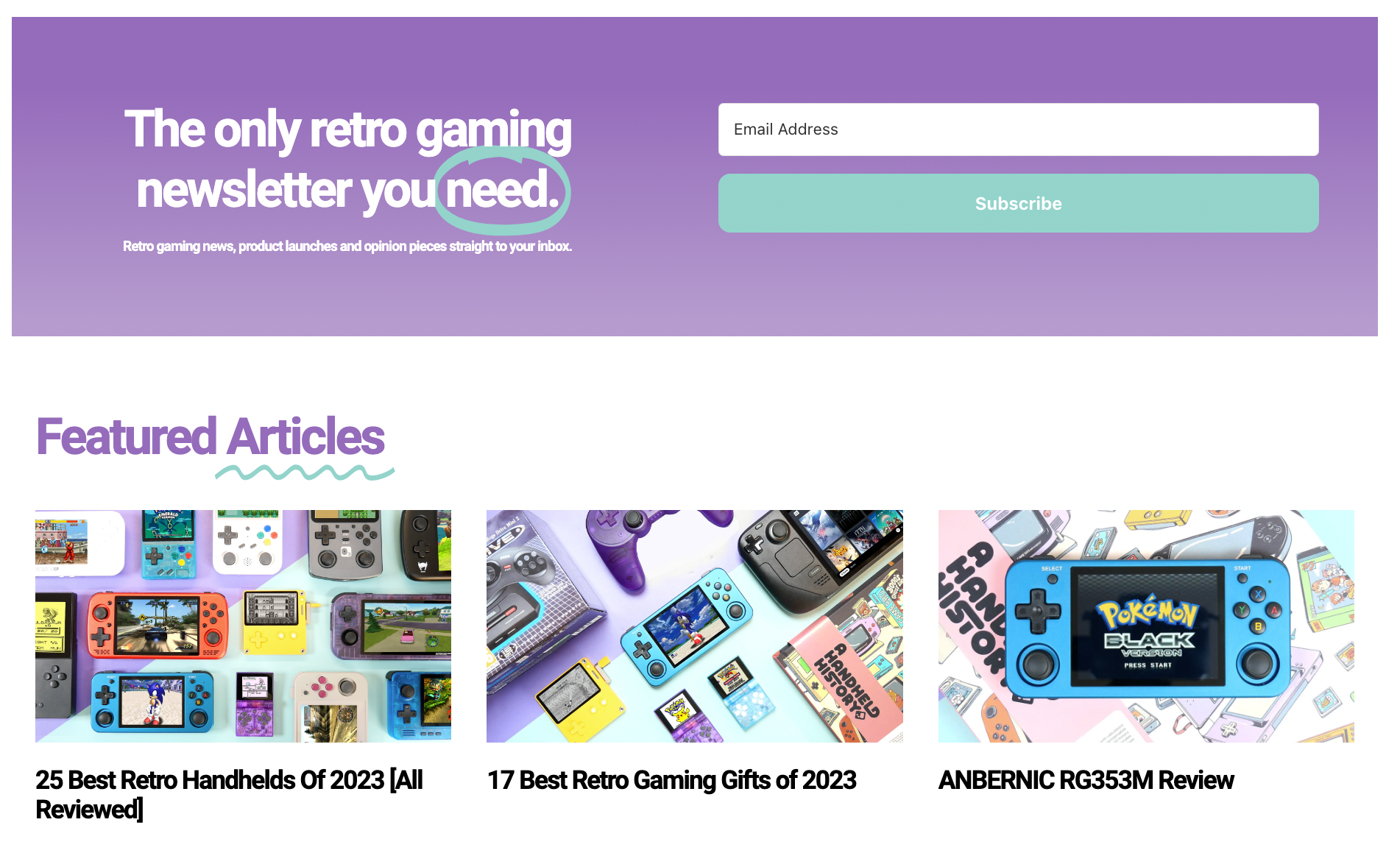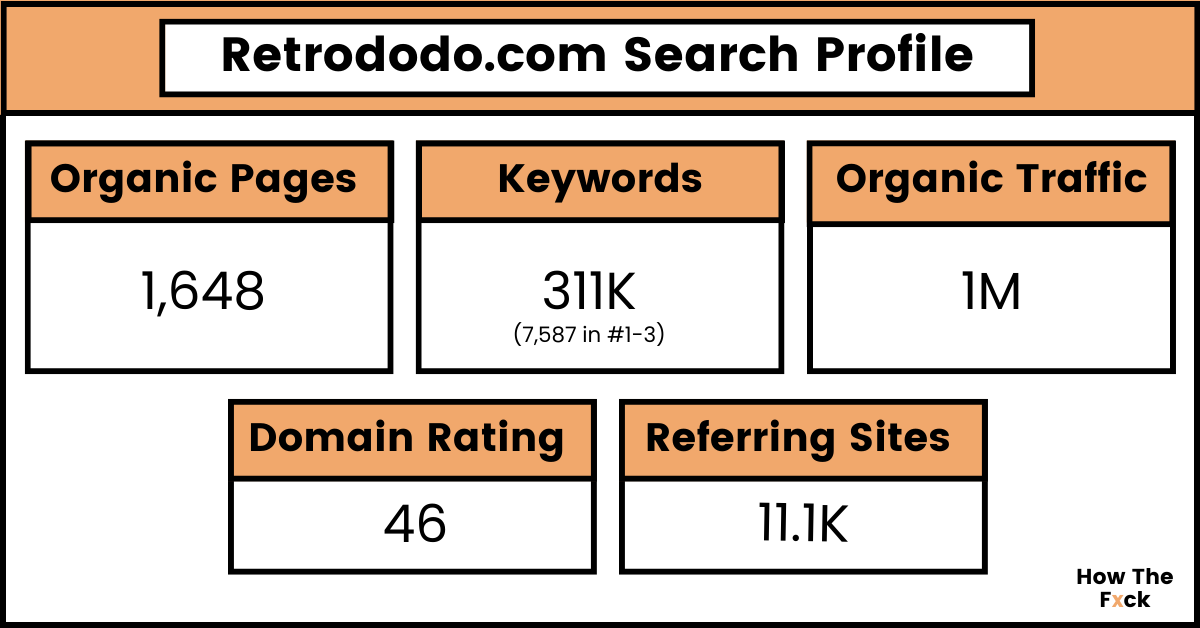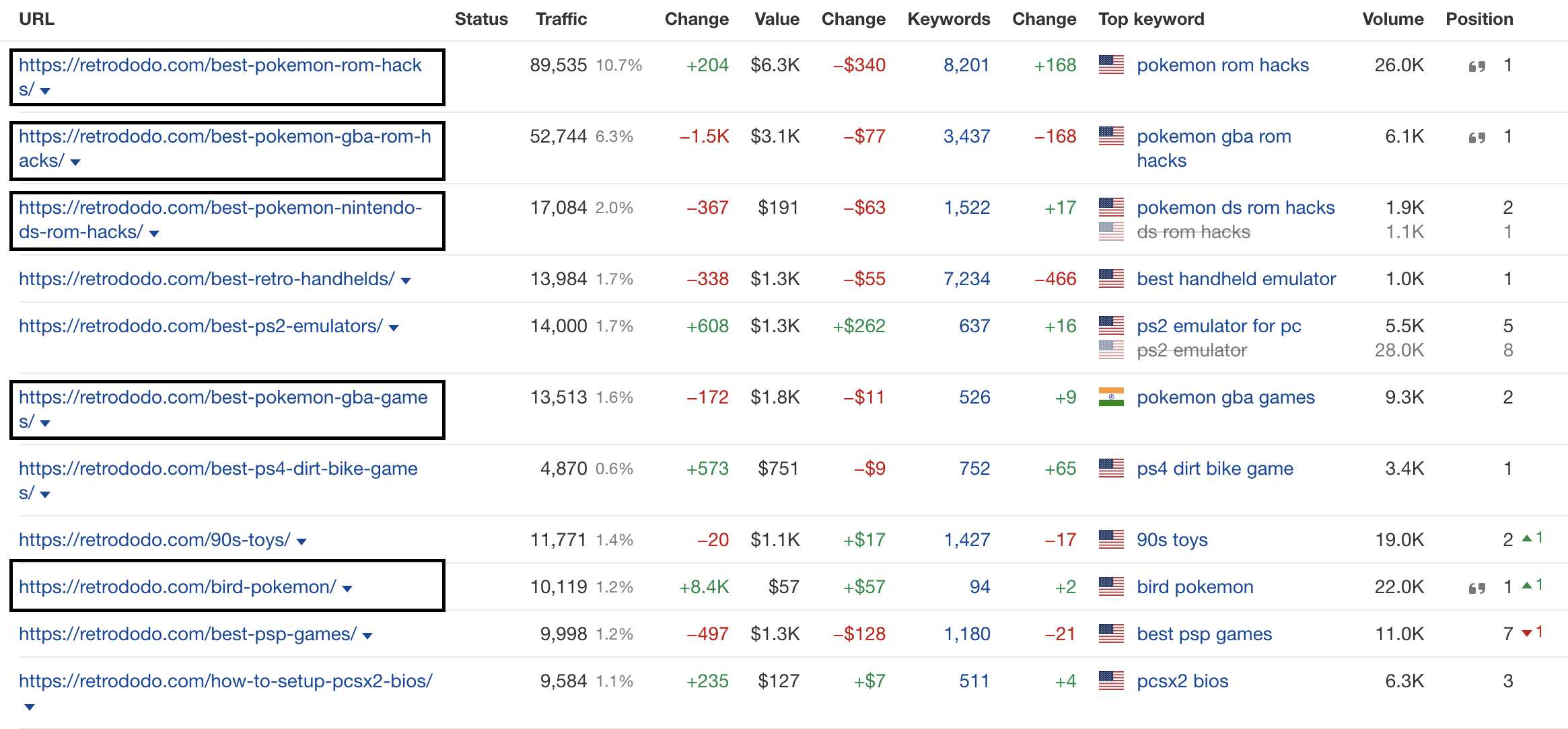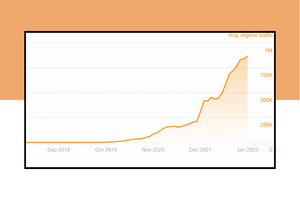The case study I share below is more of a success than many of us can dream.
In three years, from a town just 5 miles from where I live in the Somerset countryside, Brandon Saltalamacchia created a retro gaming magazine that now sits at:
⚡ 1 million monthly clicks from search
⚡ 270,000 YouTube subscribers
⚡ 85,000 social followers
⚡ $50-55K monthly revenue
That's totally life-changing. Mind-blowing. Crazy. All of the above.
Brandon's process is pretty epic. It focuses on developing high-quality video and written product reviews in networks of semantic topic clusters.
In this case study:
⚡ How to build a niche blog site around your passions that *actually* earns traffic and loyal followers.
⚡ How to build an organic content strategy that wins highly monetizable keywords (earning Retro Dodo $50K in monthly revenue!)
⚡ Best practices for interlinking, backlink building, keyword choice, and many more SEO tips.
Listen to the episode here or join How the F*ck Premium to unlock the full case study below. 👇
How Retro Dodo Grew to 1 Million Clicks & $50K Monthly Revenue in 3 Years
Retro Dodo is an online magazine dedicated to showcasing the world's best retro gaming products. Founder, Brandon Saltalamacchia, began building the site as a side project with the first piece of content going live in June 2019.
He initially published at a rate of one blog post a week, steadily moving up to two, four, and eventually hiring a writer in year two to go “all in” on the content.

Alongside the blog, Retro Dodo hosts a YouTube channel dedicated to retro console and game reviews.
Three years and 1,000s of bits of content later, Retro Dodo is a retro gaming brand that, in November 2022, pulled in:
- 1 million clicks from Google
- 270,000 total YouTube subscribers
- $50,000 in revenue
- 15,000 total Twitter followers
- 68,000 total Instagram followers

Monetization stats:
- $45k through display advertising
- $8k through affiliates
- $2-3k through YouTube ad revenue
About the Creator (Background)
Brandon has been in the niche blogging sphere for over 10 years, and like many, blogged for years without knowledge of SEO as a distribution channel. He worked at Future, a publishing company with 220 brands like GamesRadar, TechRadar, PCGamer, most of which got most of their revenue from search.
He worked in the video production team—which explains his high-quality YouTube channel for Retro Dodo but learned Search alongside the content teams at Future.
Prior to Retro Dodo, he sold a niche blog for £100,000 which focused on Van Life (campervan living and automotive) which had 50,000 YT subscribers and 250,000 Facebook followers.
“I started something I’m genuinely interested in, which is Retro Dodo, and I went in with that to create a hybrid of video and SEO. That’s my personal key to success and how I’ve got a different route to many niche sites. Now, here we are 3 years later with a million clicks and $50k a month in revenue”—Brandon Saltalamacchia
Why Building a Brand is Better Than Building a Traffic-Focused Niche Site
Retro Dodo set out to be a brand, not just a traffic-generating website. Brands have an organic strategy that extends beyond search traffic. They have a focus, a “feel”, and a customer in mind.
This is something that instantly hit me as a unique differentiator for Retro Dodo. The site spans a successful Youtube (YT) channel, a blog, a newsletter, and multiple social media accounts. It has the feel of a media company, not a build-and-flip website.
While spreading focus across multiple channels may slow growth in the short term, there are a few seriously strong advantages to this approach in the long term:
1/ Capturing your reader
Niche sites that simply focus on traffic, never capture their reader. The reader gets their information and bounces away.
However, a brand with social accounts, newsletters, and a YT channel is able to build a loyal fanbase. Capturing a reader and building them into an audience means being able to monetize them into a resilient business.
For example, if you have 1 million visitors a month and 1% of them click an affiliate link, that’s 10,000 potential affiliate leads. If another 0.5% subscribe to your newsletter and another 0.5% subscribe to your YouTube channel, that adds a further 10,000 retained fans that are an opportunity for your business.
2/ Creating a competitive advantage
If your blog is simply a blog, anyone with money can copy it. Hire a ton of freelancers and publish at velocity.
However, brands are harder to copy. If you’ve got a passion for the topic, a deep understanding of your reader, and a multimedia approach to content, it’s incredibly difficult to copy.
With the rise of AI, this point on brand is increasingly important.
“AI can’t really build a brand or community. So, moving forward over the next 5, 10, 15 years, Google’s really gonna push that forward and try to put brands with a community at the top of their search.”—Brandon Saltalamacchia
3/ Aligning with Google in the long-term
Brandon noted that he spoke to someone who sold one of the world’s biggest tech websites this year, they said:
“95% of websites out there are either really bad or they’re just okay. They’re the ones who get penalized by Google. Google wants to push the top great 5% to the top of their results because that’s what pushes their product. That’s what gives Google the respect it deserves. To do that, you have to do what the 95% won’t. Everyone’s creating a website in every niche, nobody is getting custom images, getting the products in yourself, doing video, that’s the 5% that will push you into Google’s good product.”—Brandon Saltalamacchia, How the F*ck SEO Podcast
This is an incredibly important point for niche-site creators. How do you become algorithm-proof? Be in that top 5% that Google will, over time, recognize and push forward.
I get to topic clusters later in this case study, but niching down on a topic and going all-out to create the best content on the internet, good enough to build a community around, is a strategy I suggest you follow.
Retro Dodo’s Content: Quality, Multimedia, and Winning Long-Term
Brandon noted that he’s never built backlinks for Retro Dodo. As a non-SEO by trade, his philosophy has always been to focus on creating great content.
So, what is “great content”?
Retro Dodo’s core content playbook focuses on a mixture of custom images, bespoke videos to support written content, and displaying expertise.
“We had video on our channel before we were even writing. We think Google is smart enough to know if Retro Dodo the brand also has a video on their YouTube channel about that handheld.”—Brandon Saltalamacchia
Creating multimedia content is Retro Dodo’s way of showing they’ve done their research. Whenever Brandon and his team suggest a product, their videos show they’ve used the consoles themselves and are not recommending products based on surface-level knowledge.
Retro Dodo also uses elements like an interactive summary and a table of contents to drive usability for their reader.
And, they build further trust with the reader through custom images.
When it comes to creating content that converts readers to affiliate buyers, these factors are critical to success.
Read the article here, you can see that it’s over 6,000 words and covers 25 retro handheld game consoles. Each of the 25 consoles listed also links to an individual article (example) which has its own YouTube review and written breakdown.
It’s no wonder Retro Dodo ranks #1 with such an authoritative, high-quality cluster of content like this (more on topic clusters later). Retro Dodo wins despite SERP competition from much more competitive domains:
Advertising: How much is too much?
One key question I had for Brandon was about advertising. The majority of Retro Dodo’s revenue comes from ad revenue via MediaVine ($45,000 per month).
Most high-traffic, ad-driven sites fall into the trap of spammy ads and pop-ups coating their website.
I wanted to know, where’s the balance? How much is too much?
Brandon’s response was that there is definitely a balance to be had. He notes that “I think Google will eventually rank user experience.”
The more irritated the user is by your ads, the worse the page experience. To build a brand for the long term you should avoid wrecking user experience with invasive advertising that isn’t tailored to the user.
Brandon also notes that adverts slow the site down. He moved from Ezoic because it made the website really slow. Page speed went “through the roof” after removing it and his rankings improved across the board.
Other websites go completely overboard with their advertising. For example, Forbes ads are too obnoxious to the reader and completely undermine trust:
Designing a Monetizable Content Strategy With Topic Clusters
Retro Dodo leverages topic clusters to build authority and rank for hard-to-win keywords.
Brandon notes that content clusters are important for building authority in a topic which, in turn, helps with overall ranking for all content on that topic and speed of ranking for new content.
“We built an authority on only a number of very small clusters. That’s something a lot of niche site operators need to understand, they can’t go all-guns-blazing and build a gaming brand, tech brand or travel brand, they need to really niche down and build out clusters. Once you’ve got authority, pick something else and eventually you’ll have the entire niche.”—Brandon Saltalamacchia
Before we look at Retro Dodo’s clusters, here’s how the strategy works.
1/ Pick a niche within a niche
Let’s say your niche is retro gaming. Within that niche, you have Pokemon games.
2/ Pick a highly monetizable keyword you want to win
Keywords like “best Pokemon games” and “best retro gaming handheld consoles” are more monetizable than others.
Bottom-of-funnel keywords like these signify a reader is “in-market” to purchase, which means converting them to affiliate revenue will be much easier to do.
For that reason, they’re usually more competitive. You can’t win them with just one article on that topic (see step three).
But, it’s important that you have monetization logic in mind when building a niche website. Start with the money keyword and then build a cluster than helps you win it.
3/ Map out other keywords on that topic
Head over to a keyword research tool like Ahrefs to find all the other keywords on that topic. You might be able to write 100s of other articles on that topic. Doing so will send Google a clear signal that you are THE authority on that sub-niche.
4/ Creating your content
Add your keywords to your content calendar and create the content as fast as you can. Brandon reiterates here that you should do a video, do research, and show yourself to be genuinely knowledgeable on that topic. That way you’ll win it long-term.
5/ Repeat
You’ve now completed one sub-niche (e.g. Pokemon) and can expand to build other topic clusters until you’ve built the number one brand in your overall niche.
You can imagine this strategy in a pyramid. Your foundation is your authority: all the content you’ve created on the topic. The stronger the foundations, the easier it is to get to the top (your “money” keywords) and stay there.
Let’s look at an example:
Winning Retro Handhelds Through Topic Clustering
Brandon notes that handheld gaming is a high-success area for Retro Dodo. Over the years, they’ve built 100s of articles on the topic.
Now, any new content on that topic ranks almost instantly. Google recognizes them as an authority in retro gaming handhelds.
Their core money-driving article on the topic is this one. It ranks for more than 5,000 keywords, 171 in the top 1-3, and it drives 10s of thousands of clicks each month.
This article is the “top” of the pyramid. It’s a listicle with 25 retro handheld consoles, ranked to make it easy for the reader to choose between them.
The middle layer of our pyramid, the “support content” comes in the form of individual reviews for each of the 25 consoles.
For example, this review has a dedicated unboxing video and a teardown of the console’s quality, experience, and game library.
This support content clearly shows to the reader that the “25 best handhelds” article is based on expertise with the products. Everything being recommended has been played with and assessed by a REAL human.
Internal linking is made easier when tackling entire topics like this. Internal linking helps Google easily crawl your website, and also helps PageRank flow from one article to another easily.
What about the bottom of the monetized-topic cluster pyramid?
Well, that comes from years of investment in the topic of handhelds. Retro Dodo’s niche is retro gaming. They’ve got thousands of pages on the topic.
Each of those pages together is a clear signal of topical authority in this space.
Another example of Retro Dodo’s content clusters includes Pokemon.

Retro Dodo has more than 250 posts with “Pokemon” in the title. Brandon noted that when they recently created new guides on the topic, traffic skyrocketed. Their existing authority pays dividends for the speed of ranking their new content.
What Would Brandon Do Differently If He Could Start Again?
Brandon’s advice is simple: build a newsletter from day one.
Social media can get shut down. Algorithm updates can hit search traffic. But your newsletter is yours from the start. It’s the most reliable, trustworthy, valuable collection of community you can have.
Parting Advice for Those Copying This Strategy
Brandon highly recommends building a website on a topic you’re passionate about.
If you don't pick a niche you're passionate about, you'll never get the advantages of someone who does.
— Ben Goodey (@BenGoodey) December 30, 2022
> Longevity
> Customer knowledge
> Love and care over your content
> Nuanced hot takes
Lot of power in loving what you do and doing it every day. Community/reader notices.
Pick an article topic you want to win and then build around it. To win, you’re going to have to do so much research and investigation of the product, so you better love it.


